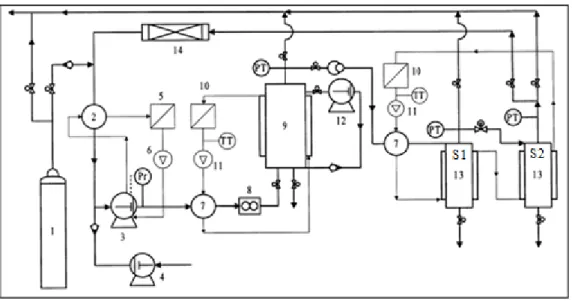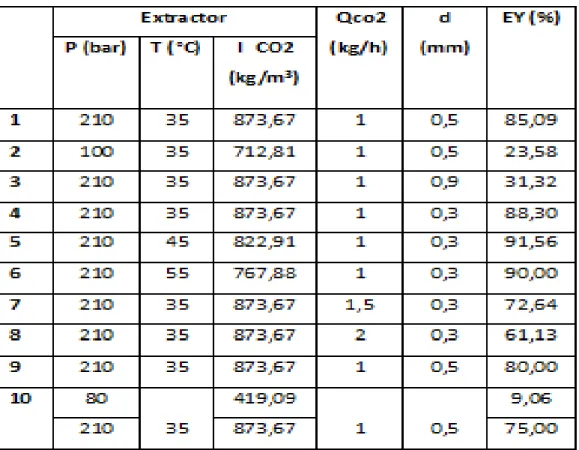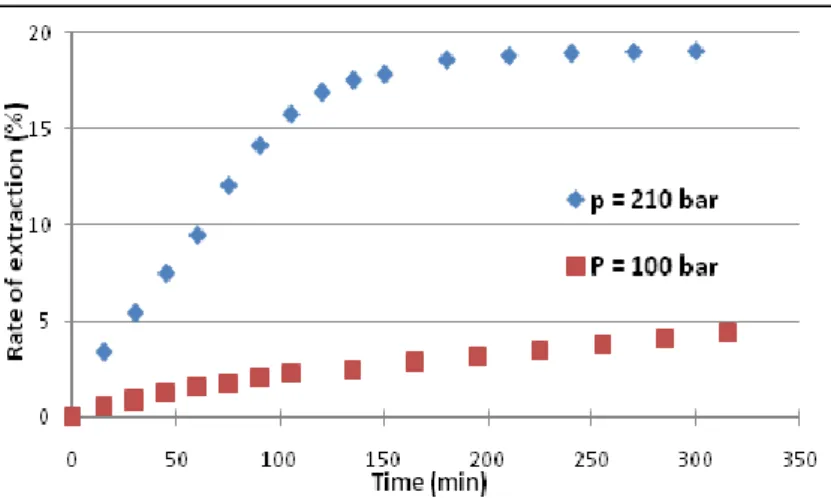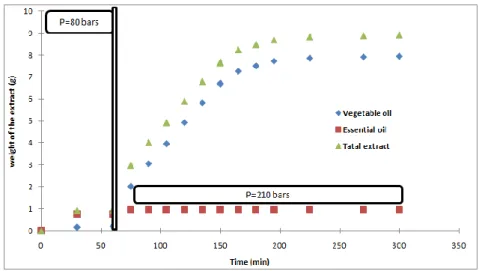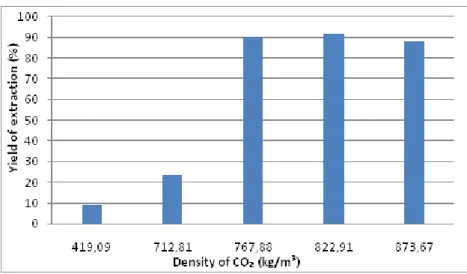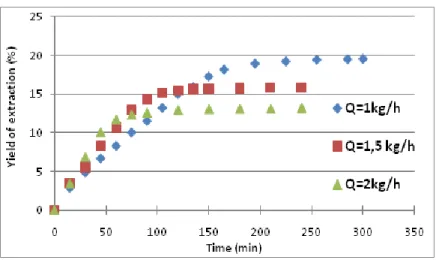HAL Id: hal-01757383
https://hal.archives-ouvertes.fr/hal-01757383
Submitted on 6 Aug 2018HAL is a multi-disciplinary open access archive for the deposit and dissemination of sci-entific research documents, whether they are pub-lished or not. The documents may come from teaching and research institutions in France or abroad, or from public or private research centers.
L’archive ouverte pluridisciplinaire HAL, est destinée au dépôt et à la diffusion de documents scientifiques de niveau recherche, publiés ou non, émanant des établissements d’enseignement et de recherche français ou étrangers, des laboratoires publics ou privés.
A one-pot process for the extraction of fats and essential
oil from coriander seeds by supercritical CO2
Houcine Mhemdi, Élisabeth Rodier, Jacques Fages, Nabil Kechaou
To cite this version:
Houcine Mhemdi, Élisabeth Rodier, Jacques Fages, Nabil Kechaou. A one-pot process for the extrac-tion of fats and essential oil from coriander seeds by supercritical CO2. 12th European Meeting on Supercritical Fluids, ISASF, May 2010, Graz, Austria. 10 p. �hal-01757383�
1
A one-pot process for the extraction of fats and essential
oil from coriander seeds by supercritical CO
2MHEMDI Houcine1,2, RODIER Elisabeth2,3, FAGES Jacques 2,3,± KECHAOU Nabil1
1
- National School of Engineers of Sfax, Unit MFAM, 02/UR/11-02, 3038 SFAX, Tunisia
2
-École des Mines d’Albi, RAPSODEE Centre, F-81013 Albi, France
3
- Université de Toulouse ; Mines Albi ; CNRS ; F-81013 Albi, France
E-mail : h.mhemdi@live.fr
Abstract
The seeds of coriander (Coriandrum sativum) are rich in vegetal oil (VO) and in essential oil (EO), which have both an interesting potential for the food, pharmaceutical and cosmetic industries. The review of the literature shows that most of the research works related to the extraction of coriander seeds are aimed at extracting either the VO or the EO. The aim of this work is to develop a process that can extract selectively the VO and EO in a consecutive way by tuning experimental conditions. A 4-step process has been set up: (i) seeds preparation by grinding and sieving, (ii) extraction by supercritical CO2 (SC CO2) and (iii; iv) selective
separation in two separators with different pressure level. The first part of this study consisted in studying the effects of the operating conditions (T, P, CO2 density, flow rate and particle
size distribution of ground seeds) on the yield of extraction. The results showed that the global performance of the process depended mainly on the pressure level, on the CO2 flow
rate and on the size of ground seeds. An optimization of the parameters gave an extraction efficiency of 90 %. The second part of this study dealt with the effects of operating conditions on the quality of extracts, and more precisely on their composition in VO and EO. It was observed that the supercritical extraction had no major effect on the fatty acid composition of the VO compared to classical extraction procedures, while EO is enriched in components such as linalol and that a previous drying of the seeds is deleterious. Finally, we proposed a protocol in order to extract separately VO and EO by tuning CO2 density and separation
conditions
Keywords : Coriander, Vegetal oil, Essential oil, Supercritical CO2, , Extraction
Nomenclature t = time (s) P = Pressure (bar) T = temperature (° C) M = Mass of extract (g) d = diameter (m) ℓ = Density (kg / m³) Q = Flow rate of CO ₂ (kg / h) D = diffusion coefficient (m² / s) EY = Extraction Yield (%) SC = SuperCritical
SCFE = SuperCritical Fluid Extraction VO = Vegetal Oil
EO = Essential Oil FA = Fatty Acid
SFA = Saturated Fatty Acid
MUFA = MonoUnsaturated Fatty Acid PUFA = PolyUnsaturated Fatty Acid ER = Extraction Rate (%)
2 INTRODUCTION
Coriander (Coriandrum sativum) is an annual Apiaceae (Umbelliferae) herb, which is widely used in food, pharmaceutical and cosmetic industries [1-3]. Coriander fruits contain vegetal oil (VO) with a high concentration of the monounsaturated fatty acid, especially petroselinic acid. This fatty acid can be oxidatively cleaved to produce a mixture of lauric acid, a compound useful in the production of detergents, and adipic acid, a C6 dicarboxylic acid which can be utilized in the synthesis of nylon polymer [4-7]. Moreover, the essential oil of coriander has been shown to have antibacterial, antioxidant, antidiabetic, anticancerous and antimutagenic activities [8-16].
There are three major extraction techniques used to obtain VO and EO from coriander seeds which are steam distillation, organic solvent extraction (soxhlet), and supercritical extraction. Each technique has its benefits and drawbacks as far as operating cost, capital cost, yield and quality of the extracts are concerned. Steam distillation is by far the most widely practiced and cheapest way of extraction, but it is limited to essential oil production only, and can sometimes cause chemical changes to the extract, by oxidation of some compounds. Organic solvent extraction is intermediate in capital and operating cost, and can be used for producing VO and EO from herbs. However, concerns over the solvent residues in the oleoresin products, new regulations concerning the limits of volatile organic solvent emissions in the air, and the extent of further refining that is required after the extraction step begin to limit the use of this technology. Supercritical extraction is the most recent technology that is assuming increasing importance in the production of EO, VO, and a range of other substances from natural products. This technique has the highest capital cost of the three techniques, and moderate operating costs. However, neither solvent residues remain in the product after extraction, nor there are any chemical changes due to the processing technique, which gives extract of outstanding quality [17-20]. The review of literature shows that most of the research works related to the extraction of coriander seeds are aimed at extracting either of the VO or the EO. The aim of this work is to develop a process using supercritical carbon dioxide, which is able to extract selectively the VO and EO in a consecutive way by tuning experimental conditions.
1. MATERIALS AND METHODS 1.1. Raw material
Coriander that was used during this research came from Canada. It was provided by the laboratory of General Herbalism, Marseille, France. The coriander seeds are kept in a refrigerator at 4°C before use. Their mass content of VO and EO, respectively determined by Soxhlet and steam distillation are 20.8% of VO and 0.4% of EO.
1.2. Particle size reduction
To study the effect of particle size on extraction yield, coriander seeds are first crushed. The grinding is performed using a grinder type IKA M20. The particle diameter after size reduction was estimated by using sieves (200 µm, 400 µm, 630 µm, 800 µm and 1 mm) to separate a known initial sample mass into weight fractions according to their corresponding particle size range.
1.3. Supercritical carbon dioxide extraction
Extraction experiments on coriander seeds were carried out on the pilot scale extraction apparatus (Separex, France) shown schematically in Figure 1. The pilot scale tests were
3
performed by flowing carbon dioxide at the required temperature and pressure through a bed of ground coriander fraction contained in the extractor. The pressure in the extractor was controlled by a backpressure regulator and temperature was regulated by an electrical device. The carbon dioxide and dissolved solute was then depressurized causing precipitation of VO into the first cyclonic separator S1 which was held at a pressure of 70 bar and a temperature of 30°C. Then carbon dioxide flowed through a needle valve causing precipitation of the remaining EO and water into the second cyclonic separator S2. This last vessel was maintained at a pressure of 40 bar and a temperature of 10° C. Samples of extract were withdrawn at regular intervals (15 min) from the separation vessels to give the time course of the extraction of oils
Figure 1. Schematic of pilot scale extraction apparatus.
1- CO2 cylinder; 2- condenser; 3- CO2 pump; 4- co-solvent pump; 5- refrigerator tank; 6- refrigerator pump; 7- heaters; 8- mass flowmeter; 9- extractor; 10- heating baths; 11-pumps of heating systems; 12- recirculation pump; 13- separators (S1 and S2); 14- filter; Pr- pressostat; PT- pressure transmitter, TT- temperature transmitter.
1.4. Characterization of the extract : Gas Chromatography 1.4.1. Fatty acid composition of Vegetal Oil
The fatty acid composition of the coriander VO was determined by analysis of their methyl esters obtained by transesterification. These esters were analyzed using a gas chromatograph
type Varian CP-select CB 3900 equipped with a silica capillary column (50 m x 0.25 mm x 0.25 m). Temperature was held at 185 °C for 4 min, raised to 250 °C at
15 °C/min. The injection and the detector temperature was 250 °C. The carrier gas was H2
(1.2 ml/min). The device was equipped with a FID detector, which gave the chromatogram for each sample. The identification of fatty acids was made by comparing their retention times with those of standard samples.
1.4.2. Composition of Essential Oil
The separation of volatile components of the coriander EO was performed using a gas
chromatograph capillary type HP 5890 series II, equipped with a DB-5MS column (30 m x 0.25 mm x 0.25 m), a detector of flame ionization (FID) and injector EPC
4
conditions. The column was held at 40 °C for 5 min and then increased at 5 °C / min up to 280 ° C over 53 min. The solvent was dichloromethane and the flow through the column was 1.3 ml/min. The FID detector was held at 300 °C. The head pressure of the column was 1.034 bar and the amount injected was 0.5 l. The identification of different constituents of EO is made by calculating the retention index (RI) and Kovats index (KI) and comparing them with those of the literature.
2. RESULTS
Our process consists in four steps, which are respectively grinding, sieving, extraction and fractionation. Indeed, coriander seeds are first ground. Then the particle size distribution was measured by sieving and the fractions collected. The mass of ground and sieved coriander seeds used in each experiment was approximately 50 g. After the extraction step, a yellow vegetal oil, slightly viscous was recovered in separator 1 (70 bar and 30°C) and a fragrant essential oil is collected in separator 2 (40 bar and 10°C). Samples of extract were removed at regular intervals (each 15 min) from the separation vessels in order to follow the kinetics of extraction. The experiment was stopped once the amount extracted remained constant and a plateau was reached on the extraction curve. Different operating conditions were used to study the influence of the pressure, the temperature, the density and the flow rate of CO2 and
the mean particle size of ground seeds to be processed on the yield and the composition of the extract (Table 1 and Table 2). The VO and the EO obtained were also compared with those obtained respectively by Soxhlet and steam distillation using the same particle size fraction (Table 2).
5
2.1. Effect of the operating conditions on extraction yield
The results are analysed according to:
The Extraction Rate (ER) that is the total mass of extract recovered at time t from 100 g of coriander. It is expressed in % (g of extract / 100 g coriander)
The Extraction Yield (EY) that is the percentage of oil extracted from the total quantity of oil contained in the seeds of coriander
2.1.1-Influence of pressure
The influence of two different pressures (100 and 210 bar) on the yield of extraction was studied at 35°C, a mean particle size of ground seeds of 0.5 mm and a supercritical fluid flow rate of 1 kg/h (Table 1 and figure 2).
Figure 2. Effect of pressure on the extraction rate versus time for T=35°C, Q=1kg/h and d=0.5mm
Analysis of the extraction curves (Figure 2) shows that the increase of pressure enhances the kinetics and greatly reduces the extraction time while increasing the extraction efficiency. Indeed, as the pressure increases from 100 to 210 bar, the extraction yield rises from 23% to 85% and the time needed to achieve the extraction decreases from more than 300 min to 200 min. These effects could be attributed to the increase of the CO2 density, which improves its
solvent power and then the solubility of the solute. The effect of pressure on extraction has been observed by several research teams who have worked on the extraction of oil seeds by supercritical CO2 [8-15]. In addition, to go further in the enhancement of the extraction
kinetics, diffusivities of the solute transferred into the supercritical fluid were evaluated using the mathematical model of Owen and al [7]. Indeed, the values of diffusivities at a pressure of 100 bar and 210 bar were respectively 0.5 x 10-13 m2/s and 1.06 x 10-13m2/s.
When the pressure increases from 100 bar to 210 bar, the amount of extracted EO remains the same while the amount of HV extracted increases significantly. Data from the literature [4] show that for a solvent density less than 500 kg / m3, only EO can be extracted while a higher density is required to extract the VO. The extraction of EO can then be performed at a moderate enough pressure of 100 bar while the VO extraction requires higher pressures. To confirm this observation, an extraction test in two steps was performed in order to extract first the EO and second the VO at two different pressures (80 bar and 210 bars) and thus at two different densities (Figure 3):
- First Step: 80 bar and 35 ° C, which corresponds to a CO2 density of 419.9 kg/m3
6
Figure 3. Effect of pressure on the selectivity of extraction in two steps
Figure 3 shows that during the first extraction step (80 bar), only the EO was recovered while in the second stage (210 bar) only VO was recovered. These results confirm those of literature, the previous comments about the effect of pressure and density of CO2 on the
selectivity of the extraction of EO and HV. We can conclude that the extraction in two steps allows to extract selectively the VO and the EO from coriander seeds.
2.1.2. Influence of temperature
The influence of the temperature was studied using the following extraction conditions of pressure, flow rate, and particle size: 210 bar, 1 kg/h and 0.3 mm (Table 1 and figure 4)
Figure 4. Effect of temperature on the extraction rate for P=210 bar, Q=1kg/h and d=0.3mm
The temperature did not have a significant effect on the extraction rate. At 35°C, the extraction yield was 88% and at 55°C it was 91%. This limited or even lacking effect of the temperature could be explained by two opposite phenomena that occur simultaneously. Indeed, the increase of temperature induces a drop of the solvent density and of the solvent power, so the rate of extraction decreases. In the same time, the rise in temperature induces an increase of the solute vapour pressure and therefore its solubility in the supercritical fluid, so the extraction efficiency increases. These two opposite effects are competing. It has been often observed that the effect of vapour pressure prevails and the result is a positive effect on the extraction rate [21]. In our case, the balance of both effects appears without significant impact.
7
2.1.3. Influence of density of CO2
The study of the effect of pressure and temperature on the extraction led to study the influence of solvent density on the extraction yield. 5 extraction tests were performed for 5 different values of density and under the same conditions of particle size (0.3 mm) and flow of CO2
(1 kg/h) (Table 1 and Figure 5).
Figure 5. Effect of the density of CO₂ on the extraction yield for Q=1kg/h and = 0.3mm
The extraction yield drastically increases with density, that is from 9% for a density of 400 kg / m3 to 90% for a density value of about 800 kg / m3. This increase was due to the enlargement of the solvent power of the carbon dioxide with its density. However, increasing the density above 800 kg / m3 improves the extraction efficiency
2.1.4. Influence of the particle size
Figure 6. Effect of the particle size on the extraction rate for P=210 bar,T=35°C & Q=1kg/h
Reducing the particle size from 0.9 mm to 0.5 mm improves the extraction yield from 23% to 90%. This can be attributed to the increase of the contacting area and to the decrease of the transfer resistance. The diffusivity is estimated to be 1.08 x 10-13 m2 / s for particle size of 0.3 mm while the one for a diameter of 0.9 mm is smaller and equal to 0.1 x 10-13 m2 / s
8
2.1.5. Influence of flow rate
To study the effect of solvent flow rate on extraction efficiency, three extraction tests were performed under the same operating conditions with three different flow rates of CO2 which
are respectively 1 kg / h, 1.5 kg / h and 2 kg / h. (Table 1 and figure 7)
Figure 7. Effect of the flow rate on the extraction yield versus time for 210 bar, 35°C and 0.3 mm
Increasing the flow of CO2 accelerates the kinetics of extraction. Indeed, the time required to
reach the plateau decreased from 160 minutes for 1 kg / h to 80 minutes for 2 kg / h. However, the extraction yield decreases from 90% to 61% when the flow of CO2 increases to
2 kg / h. This result may be explained by the reduction of the contact time between the carbon dioxide and the bed of coriander during the extraction step.
2.2. Effect of the operating conditions on the composition of VO and EO 2.2.1 Vegetal oil of coriander
Different samples of VO are analyzed by GC and their fatty acid composition is shown in Table 2.
9
The VO of coriander is very rich in unsaturated fatty acid: about 95% are unsaturated, 80% are monounsaturated and 15% are polyunsaturated. The major fatty acid is petroselinic acid (>70%). These values are similar to the results found by Msaada and Holmes [5,6].Comparison between the composition of the VO obtained by organic solvent extraction (Soxhlet) and that obtained by supercritical CO2 shows that both fatty acid profiles are similar.
However, we note that 10 fatty acids have been identified from VO obtained by supercritical CO2, while only 9 have been identified from the VO extracted by Soxhlet, which does not
contain arachidic acid but it is richer in gadoleic acid (0.10%) than the VO extracted by supercritical extraction (0.39%). We note also that operating conditions (T; P, Q and d) have no major effect on the fatty acid composition of VO.
2.2.2. Essential oil of coriander
The composition of the EO obtained after the supercritical extraction and the one obtained by steam distillation were determined. The EO extracted from seeds of coriander, which were previously dried at 70 °C and 600 mbar for 24 h was also analyzed.
Results show that EO extracted by supercritical CO2 contains 29 compounds, whereas 35
compounds were identified in the case of extraction by steam distillation. This could be attributed to hydrolysis and / or oxidation of certain compounds of the EO during the extraction by steam distillation. We note also that EO extracted by supercritical CO2 is richer
in linalool and in limonene (66% and 3%) than that obtained by hydrodistillation (57% and 0.02%). Drying coriander seeds before extraction affects the quality of the EO. Indeed, only 16 compounds were identified after drying. This could be explained by the evaporation of some of the volatile compounds during drying.
CONCLUSION
Coriander seeds were extracted using supercritical carbon dioxide to obtain selectively vegetal oil and essential oil. A process in 4 steps has been set up. A range of pressure, temperature, particle diameters and flow rates were used to study the effect of operating conditions on the yield extraction and the composition of the extract. The results showed that pressure, particle size and flow rate have a significant effect on the extraction yield and they have no major effect on the composition of VO and EO. The VO obtained is rich in petroselinic acid, while linalool is the major compound of the EO. 210 bar and 35 ° C as extraction conditions together with a superctitical fluid flow rate of 1 kg/h and a mean size of 0.5 mm for the ground seeds were the best conditions tested to extract vegetal oil of good quality and to maximize the extraction yield (90%). In addition, 100 bar in the extractor are enough to extract selectively essential oil.
Acknowledgments: this work is part of a research project financed with the help of Région
Midi-Pyrénées which is gratefully acknowledged. The authors thank the team from LCA-ENSIACET Toulouse and especially Mr Thierry Talou for the chromatographic analyses.
10 REFERENCES
[1] CHITHRA, V., LEELAMMA, S., Journal of Ethnopharmacology, Vol. 71, 2000, p 457 [2] GALLAGHER, A., M., FLATT, P., R., DUFFY, G., ABDEL-WAHAB, Y., H., A., Nutrition Research, Vol. 23, 2003, p 413
[3] BURDOK, A., CARABIN, G., Food and chemical Toxicology, Vol. 47, 2009, p 22
[4] HOLMES, R., L., MOREU, J., P., SUMRELL, G., Journal of the American Oil Chemists Society, Vol. 42, 2007, p 922
[5] MSAADA, K., HOSNI, K., BEN TAARIT, M., CHAHED, T., HAMMAMIB, M., MARZOUK, B., Scientia Horticulturae, Vol. 120, 2009, p 525
[6] MSAADA, K., HOSNI, K., BEN TAARIT, M., CHAHED, T., HAMMAMIB, M., MARZOUK, B., Industrial Crops and Products, Vol. 29, 2008, p 269
[7] OWEN, J., CATCHPOLE, JOHN, B., G., The Journal of Supercritical Fluids, Vol. 9,
1996, p 273
[8] BANDONI, A., L., MIZRAHI, I., JUAREZ, M., A., Journal of Essential Oil Research, Vol. 10, 1998, p 581.
[9] BURDOK, A., CARABIN, G., Food and chemical Toxicology, Vol. 47, 2009, p 22. [10]BURT, S., International Journal of Food Microbiology, Vol. 94, 2004, p 223.
[11] EMAMGHOREISHI, M., KHASAKI, M., AAZAM, M., F., Journal of Ethnopharmacology, Vol. 96, 2005, p 365.
[12] MSAADA, K., HOSNI, K., BEN TAARIT, M., CHAHED, T., KCHOUK, M., E., MARZOUK, B., Food Chemistry, Vol. 102, 2007, p 1131.
[13] WANGENSTEEN, H., SAMUELSEN, A., B., MALTERUD, K., E., Food Chemistry, Vol. 88, 2004, 293.
[14] GROSSO, C., FERRARO, V., FIGUEIREDO, A., C., BARROSO, J., G., COELHO, J., A., PALAVRA, A., M., Food Chemistry, Vol. 111, 2008, p 197.
[15] KUBO, I., FUJITA, K., I., KUBO, A., NIHEI, K., I., OGURA, T., Journal of Agricultural and Food Chemistry, Vol. 52, 2004, p 3329
[16] MATASYOH, J., C., MAIYO, Z., C., NGURE, R., M., CHEPKORIR, R., Food Chemistry, Vol. 113, 2009, p 526.
[17] ANITESCU, G., DONEANU, C., RADULESCU, V., Flavour and Fragrance Journal, Vol. 12, 1997, p 173.
[18]MONFORT, F., Les applications des fluides supercritiques, Ptaa. France, 2001, p 1-5. [19] MIRA, B., BLASCO, M., BERNA, A., SUBIRATS, S., Journal of Supercritical Fluids, Vol. 14, 1999, p 95.
[20] ILLES, V., DAOOD, H., G., PERNECZKI, S., SZOKONYA, L., THEN, M., Journal of Supercritical Fluids, Vol. 17, 2000, p 177.
[21] BRUNNER, G., Gaz Extraction (BAUMGARTEL, H. et FRANCK, U. edit.),Topics in Physical Chemistry. New York , 1994, p 3-163.
